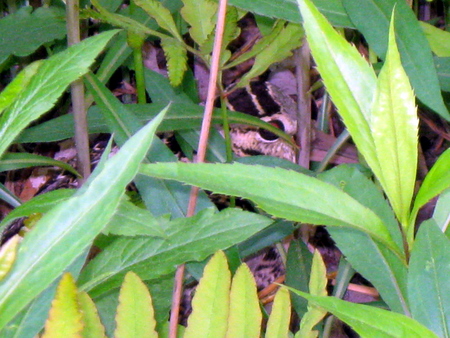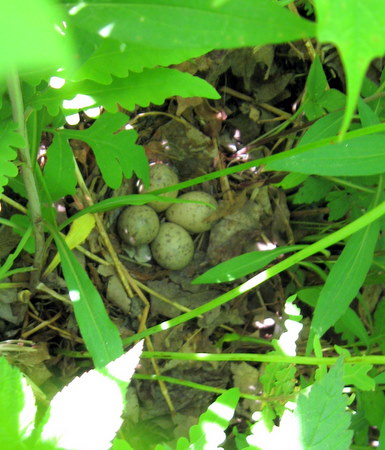
We hope you can find the American Woodcock in this photo. Camouflaged well, she is sitting on a nest, which is just leaf litter on the ground actually, of four eggs, the typical clutch for this species. She was first spotted on May 17th, when she was seen flying low, landing and doing the “broken wing” distraction display. This enabled us to find her nest, which is less than 12 inches from the edge of our lawn, in a heavily wooded area in Fayston. We had heard male Woodcocks “peenting” and doing their “sky dance” nearby since mid April.
Not wanting to disturb the bird to the point where she would abandon her unhatched young, before we approached the nest again, we made inquiry on Vermont Bird and got a reply that led us to David Capen at UVM. David had assisted with a Woodcock breeding study when he was a graduate student. He reported that females are very attached to the nest and that only strong disturbance would be a problem. The bigger issue he noted, was leaving a scent trail which would allow predators to find the nest. He said some field biologists use moth balls to cover their scent, and that rubber boots left less of a scent trail than leather.
The photo above was taken on May 21st, 4 days after we first saw the bird. With an incubation period of 21 days, we figure that no later than about June 7th, and perhaps sooner, the chicks will be hatched. Capen also noted that Woodcock chicks are very precocious, which means that they hatch with feathers, their eyes open and able to locomote on their own. He suspects it will be hard to get a look at the chicks once they hatch.
The female does have to leave the nest to eat. Sunday morning 5/25 at about 8am, we saw a Woodcock in flight and correctly surmised it was the nesting female and were able to snap this photo (after donning rubber boots and securing the family dog inside with no view of the nest area) before she returned.
